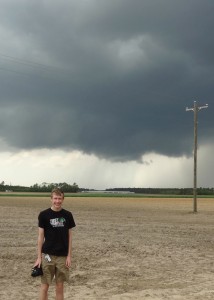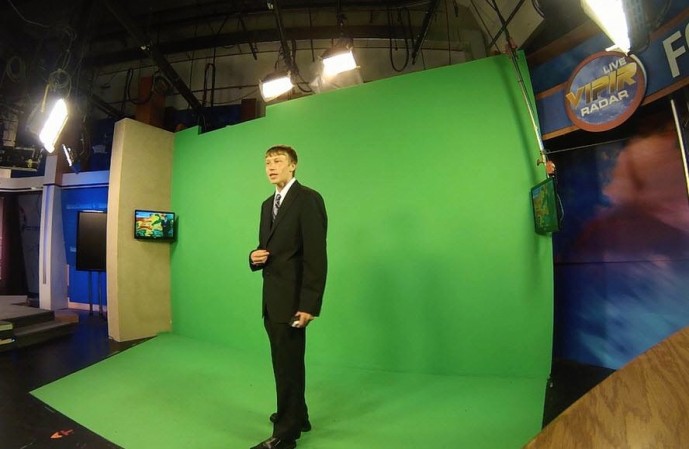On a stormy April day in 2014, UNC Charlotte meteorology undergraduate Ricky Matthews found himself traversing central North Carolina in pursuit of a line of storms that eventually spawned three tornadoes.
Matthews followed the storms not for the thrill, but for the science. He is driven to translate the science and the potentially dangerous power of weather so that the public can understand and take action.
“I want to be the person who is telling people to take cover, the person who does their best to save lives,” Matthews said. “When severe weather hits, meteorologists need to be the voice of information and reason so that people can protect their property and their lives.”
Matthews, who expects to complete his bachelor’s degree in May 2015, has wanted to be a meteorologist since the second grade, when a Nor’easter impacted the Hampton Roads region where he lived in Virginia. In middle school, he shared the daily weather forecast on his school’s announcements and was chosen a KidCaster on local television.
At UNC Charlotte, Matthews has sought to understand why people heed or ignore warnings and forecasts, making it his goal to improve the warning and information dissemination process so that lives can be saved during severe weather, using an array of knowledge and tools to do so.
 On April 25, Matthews and graduate student Thomas Winesett became concerned about imminent severe weather and tornados across North Carolina and decided to chase the storms. Their goal was to take photographs of tornadoes and other severe weather to send to local TV stations and the National Weather Service, to improve people’s access to up-to-date information.
On April 25, Matthews and graduate student Thomas Winesett became concerned about imminent severe weather and tornados across North Carolina and decided to chase the storms. Their goal was to take photographs of tornadoes and other severe weather to send to local TV stations and the National Weather Service, to improve people’s access to up-to-date information.
“There are many reasons why meteorologists and weather enthusiasts chase storms,” Matthews said. “Some do it for the thrill or to record video and make money. Others, like me, do it to try to help the NWS and local media. People want multiple and visual confirmations of a threat before taking action. It was our hope that if the public saw the storm, they would take action.”
The two headed east near Dunn, North Carolina when the National Weather Service upgraded the risk for severe weather, including tornadoes. In their first clear view of the storm, the UNC Charlotte students noted a wall cloud, indicating rotation and a precursor to a tornado. As they followed the storm through Goldsboro, it eventually produced a tornado. They tracked three different tornadoes that day, capturing photographs of wall clouds, cyclones and hail larger than golf balls.
Storms like these reaffirm Matthews’ interest in pursuing meteorology as a career and seeking ways to better engage the public in understanding weather’s potential impact. “The devastating number of deaths from recent tornado outbreaks has just further enhanced my desire to change the current form of meteorology for the better,” he said.
Matthews has held internships at three different news stations. The latest was with Time Warner Cable News in Charlotte, where he assisted meteorologists in creating weather graphics, wrote the morning forecast discussion for the website, and gained experience on the chroma key, which is a special effects technique along the lines of using green-screens to replace images.
Students Seek Innovative Ways to Inform Public
In Matthews’ quest to improve access to up-to-date weather information, he and another student created the Twitter account @unccweather to provide weather information through social media. With the number of followers spiking with a snowstorm last February, this account has proven a viable weather source for people in the UNC Charlotte area, with over 2,200 followers.
“I feel that the UNC Charlotte community has become more weather aware due to our Twitter account,” Matthews said. “Social media is big in today’s society and for students to be able to get the weather with just a click of a button makes the page a great resource.”
Also during this snowstorm, Matthews captured images of the UNC Charlotte campus, including one that the College of Liberal Arts & Sciences used as its holiday card, with Matthews’ permission.
He previously had worked with Niner Media, providing a five-day forecast to the campus newspaper, the Niner Times; creating a weekly weather video segment; and hosting a weather and news radio talk show for Radio Free Charlotte.
Matthews is president of the S.T.O.R.M. meteorology club and a student member of the National Weather Association and the American Meteorological Society. He was also key in helping UNC Charlotte achieve StormReady ® Certification. Working with campus police, administration and the National Weather Service, he organized a Skywarn class on campus, distributed information about the classes and participated in discussions regarding severe weather shelter plans.
Matthews received his NWS Skywarn Spotter certification in May 2009 from the National Oceanic & Atmospheric Administration. As a Skywarn spotter, Matthews is responsible for accurately identifying and reporting severe local storms to the NWS to help keep the community safe.
Matthews continues to seek ways to communicate about the weather. He is working with other meteorology students, with the support of the Department of Geography and Earth Sciences, the College and others on campus, to plan the first Charlotte WeatherFest on on UNC Charlotte’s campus on March 21 from 1 to 5 p.m. The public can talk with local meteorologists to learn more about the types of weather Charlotte experiences. The event also will feature displays, presentations and learning activities for children. More information will be posted on exchange.charlotte.edu and on the Department of Geography and Earth Sciences website.
Words: Tyler Harris, Student Communications Assistant
Images: Courtesy of Ricky Matthews








